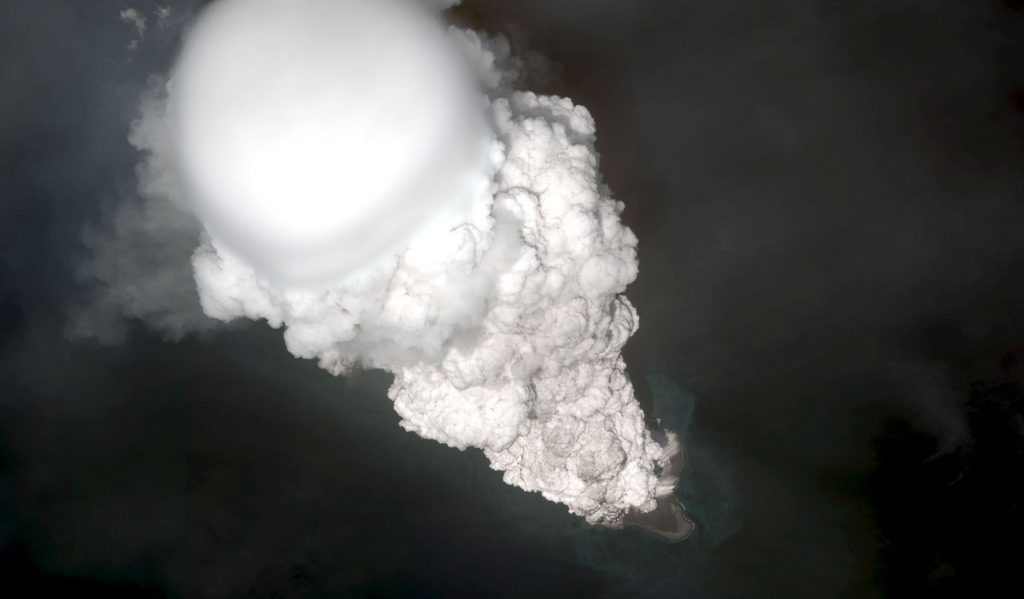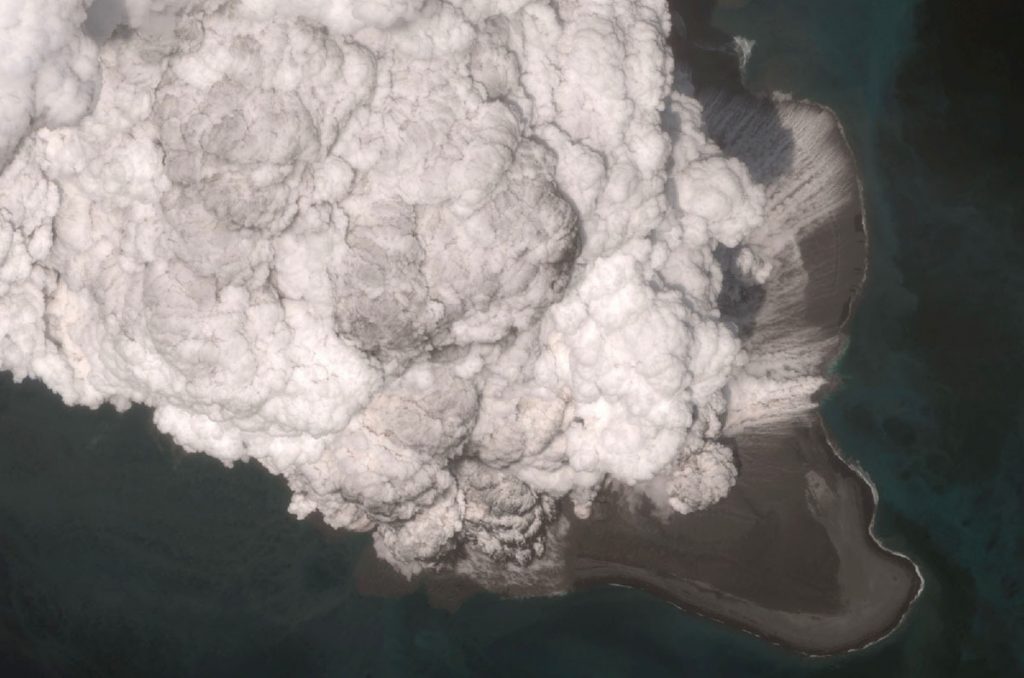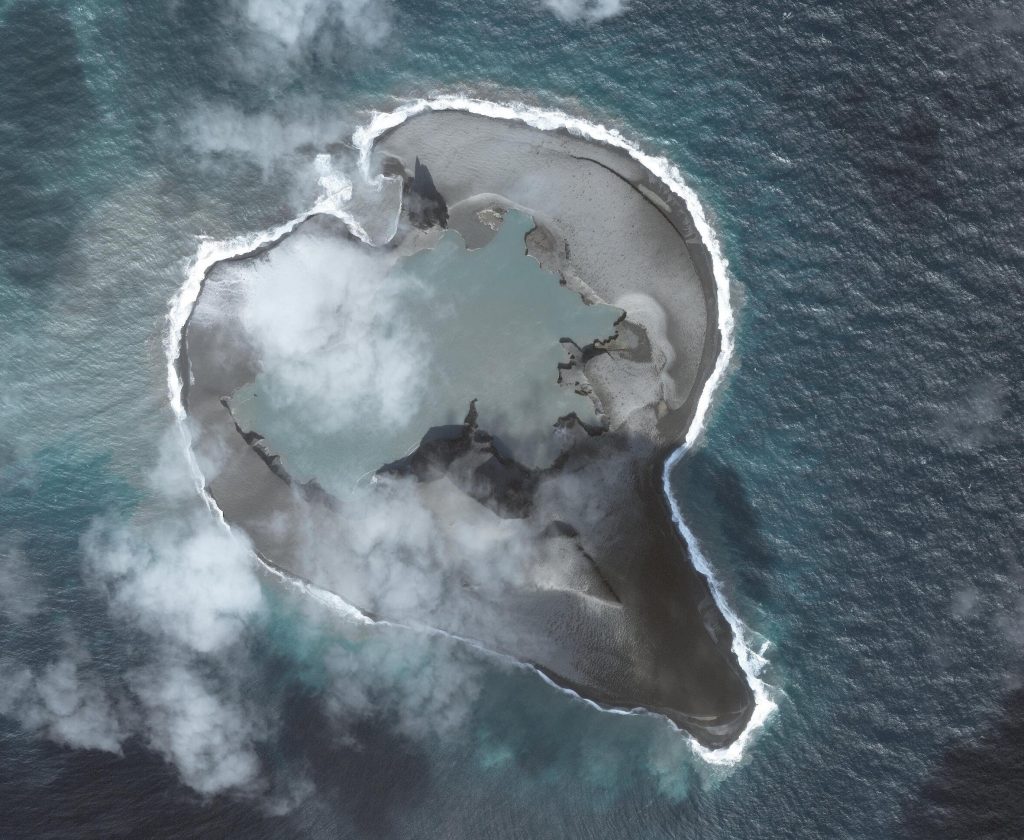13 March 2018
WASHINGTON D.C. — Researchers report in a new study that they’ve documented rumblings of volcanic thunder for the first time, a feat considered nearly impossible by many volcanologists.
Microphones set out to detect volcanic eruptions in Alaska’s Aleutian Islands recorded sounds of Bogoslof volcano erupting over eight months from December 2016 to August 2017. Researchers analyzing the recordings identified several cracking sounds from eruptions on March 8 and June 10 as volcanic thunder, a phenomenon the study authors said has never before been captured in audio recordings.

This satellite image shows Bogoslof volcano erupting on May 28, 2017. The eruption began about 18 minutes prior to this image and the cloud rose to an altitude greater than 12 kilometers (40,000 feet) above sea level.
Credit: Dave Schneider / Alaska Volcano Observatory & U.S. Geological Survey.
Observers have described hearing volcanic thunder in the past, but scientists have been unable to disentangle the booms of thunder caused by volcanic lightning from the cacophony of bellows and blasts that accompany an explosive eruption. In the new study, researchers used microphones on a nearby island and maps of volcanic lightning strokes to identify the sounds of thunder.
“It’s something that people who’ve been at eruptions have certainly seen and heard before, but this is the first time we’ve definitively caught it and identified it in scientific data,” said Matt Haney, a seismologist at the Alaska Volcano Observatory in Anchorage and lead author of the new study accepted for publication in Geophysical Research Letters, a journal of the American Geophysical Union.
This audio file contains 20 minutes of microphone data recorded during the March 8, 2017 Bogoslof eruption, sped up 60 times. The volcanic thunder sounds are the quick clicks and pops heard throughout, while the sounds of the eruption are the lower-pitched whirring sounds. The eruption ends halfway through, at the 10-second mark, after which the thunder can be heard more clearly.
Credit: Matt Haney / Alaska Volcano Observatory & U.S. Geological Survey.
Analyzing volcanic thunder offers scientists a new way of detecting volcanic lightning and potentially a way to estimate the size of an ash plume, according to Jeff Johnson, a geophysicist at Boise State University who was not connected to the new study.
Haney and his team found the intensity of the thunder matched the intensity of the lightning, meaning researchers might be able to use thunder as a proxy for volcanic lightning, Johnson said. The intensity of lightning in a volcanic plume can tell scientists how big the plume is and how hazardous it might be.
“Understanding where lightning is occurring in the plume tells us about how much ash has been erupted, and that’s something that’s notoriously difficult to measure,” Johnson said. “So if you’re locating thunder over a long area, you could potentially say something about how extensive the plume is.”
Monitoring impending eruptions
Volcanic eruptions are inherently noisy – explosions of smoke, ash and magma shake the ground and create loud bangs and rumbles that reverberate for miles. Lightning is common in volcanic plumes because particles of ash and ice scrape and collide with each other and become electrified. Researchers assumed volcanic lightning is followed by thunder, as it is during thunderstorms, but they had not yet been able to tease out thunderclaps from the noises of the eruption itself, and many scientists considered it impossible, according to Haney.
In the new study, scientists detected thunder at Bogoslof volcano in Alaska’s Aleutian Islands, a chain of more than 50 volcanic islands in the northern Pacific Ocean.
Researchers constantly monitor the islands from afar for signs of impending eruptions. They use seismic sensors to pick up ground movement before or during an eruption, arrays of microphones to detect sounds of ash exploding skyward and a global network of lightning sensors to detect lightning strokes within an ash plume. Thunderstorms are rare in the Aleutian Islands, so when sensors detect lightning, it most likely means there’s an ongoing eruption, Haney said.

A closer look at the satellite image of the Bogoslof eruption on May 28. The explosions at the base are called tephra jets, which form when extremely hot volcanic material and gas meet water, transforming into particle-filled clouds of steam.
Credit: Dave Schneider / Alaska Volcano Observatory & U.S. Geological Survey.
Bogoslof started erupting in December 2016 and erupted more than 60 times through August 2017. Many of the eruptions produced towering clouds of ash more than six kilometers (20,000 feet) high that disrupted air travel throughout the region.
Isolating thunderclaps
Bogoslof’s eruptions on March 8 and June 10 created ideal conditions for observing volcanic thunder, Haney said. Both eruptions generated immense ash plumes that persisted for several hours after the eruptions ceased. Without the din of an eruption in the background, researchers had a better chance of hearing cracks of thunder caused by lightning in the plume.

A satellite image of Bogoslof volcano on March 11, 2017. The eruption on March 8 produced large changes in the shape and size of the island. The most active vent for the explosive activity is located under the water in the center of the island, and it was greatly enlarged by the March 8 event. The western coastline has grown, and a new vent was produced on the north shore of the island.
Credit: Dave Schneider / Alaska Volcano Observatory & U.S. Geological Survey.
Worldwide lightning sensors detected lightning strokes in the ash plumes for several minutes after each eruption ended. In the new study, Haney and his colleagues compared the timing and location of the lightning strokes to sounds recorded by a microphone array on a nearby island.
They found the timing and volume of the sounds the microphones picked up matched the lightning data in a way only thunder could.
On March 8, the microphones recorded at least six distinct bursts of sound that occurred three minutes after lightning activity in the plume peaked. The timing of the bursts means they were almost certainly thunderclaps caused by the lightning: The microphones were 60 kilometers (40 miles) away from the volcano, so it would have taken sound three minutes to reach the microphones. That the thunder was picked up so far away also means it was quite loud, Haney said.
This audio file contains 5 minutes of microphone data recorded during the March 8, 2017 Bogoslof eruption, sped up 10 times. The recording captures thunder from 10:21:30-10:26:30 UTC on March 8, after the eruption had ended.
Credit: Matt Haney / Alaska Volcano Observatory & U.S. Geological Survey.
On June 10, the microphones picked up bursts of sound coming from a slightly different direction than sounds from the eruption. The location of the bursts corresponded to areas of peak lightning activity, according to the study.
“If people had been observing the eruption in person, they would have heard this thunder,” Haney said. “I expect that going forward, other researchers are going to be excited and motivated to look in their datasets to see if they can pick up the thunder signal.”
###
The American Geophysical Union is dedicated to advancing the Earth and space sciences for the benefit of humanity through its scholarly publications, conferences, and outreach programs. AGU is a not-for-profit, professional, scientific organization representing 60,000 members in 137 countries. Join the conversation on Facebook, Twitter, YouTube, and our other social media channels.
Notes for Journalists
This research article is available for free for 30 days. A PDF copy of the article can be downloaded at the following link: http://onlinelibrary.wiley.com/doi/10.1002/2017GL076911/pdf.
Journalists and PIOs may also order a copy of the final paper by emailing a request to Lauren Lipuma at [email protected]. Please provide your name, the name of your publication, and your phone number.
Neither the paper nor this press release is under embargo.
“Volcanic thunder from explosive eruptions at Bogoslof volcano, Alaska”
Authors:
Matthew M. Haney, John J. Lyons: Alaska Volcano Observatory, U.S. Geological Survey Volcano Science Center, Anchorage, Alaska, U.S.A.;
Alexa R. Van Eaton, Rebecca L. Kramer: Cascades Volcano Observatory, U.S. Geological Survey Volcano Science Center, Vancouver, Washington, U.S.A.;
David Fee, Alexandra M. Iezzi: Alaska Volcano Observatory, University of Alaska Fairbanks Geophysical Institute, Fairbanks, Alaska, U.S.A.
Contact information for the authors:
Matthew M. Haney: [email protected], +1 (907) 786-7111 (office), +1 (907) 887-9724 (cell).
Lauren Lipuma
+1 (202) 777-7396
[email protected]